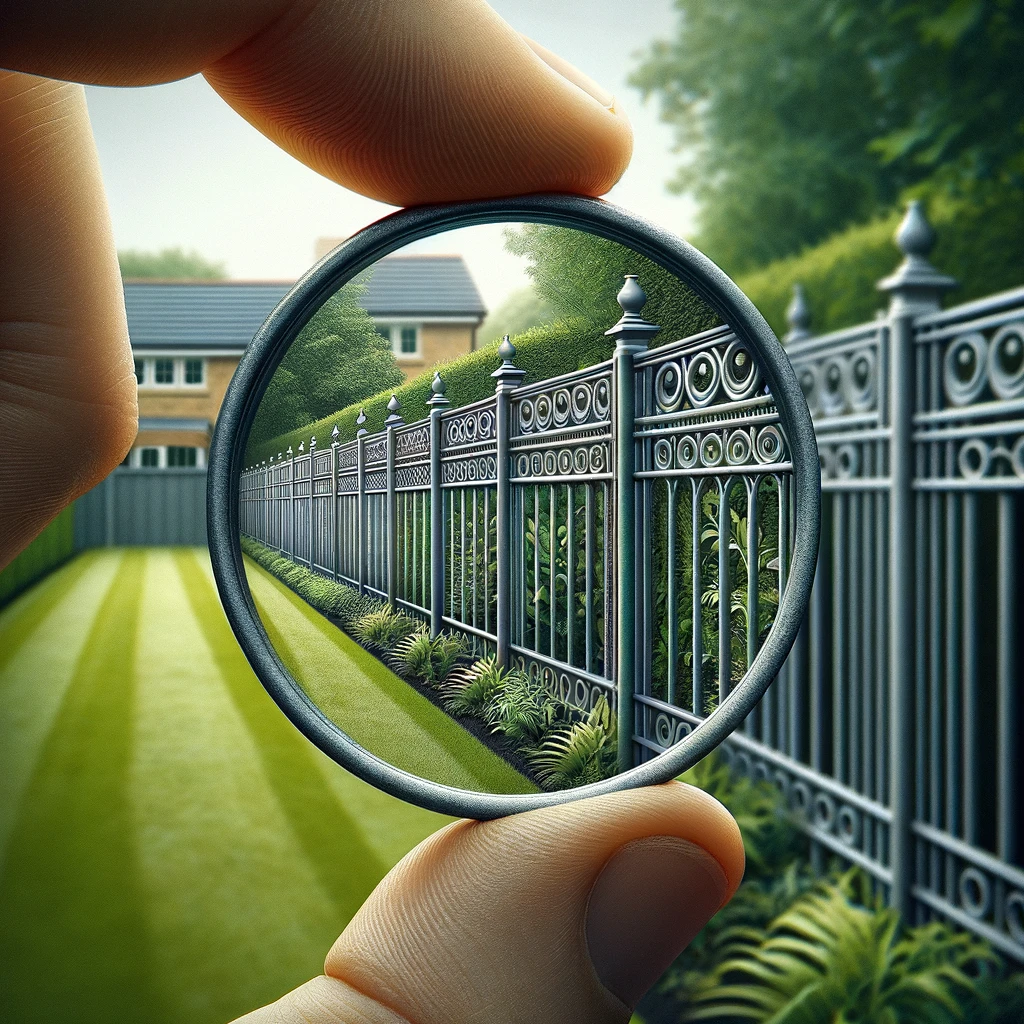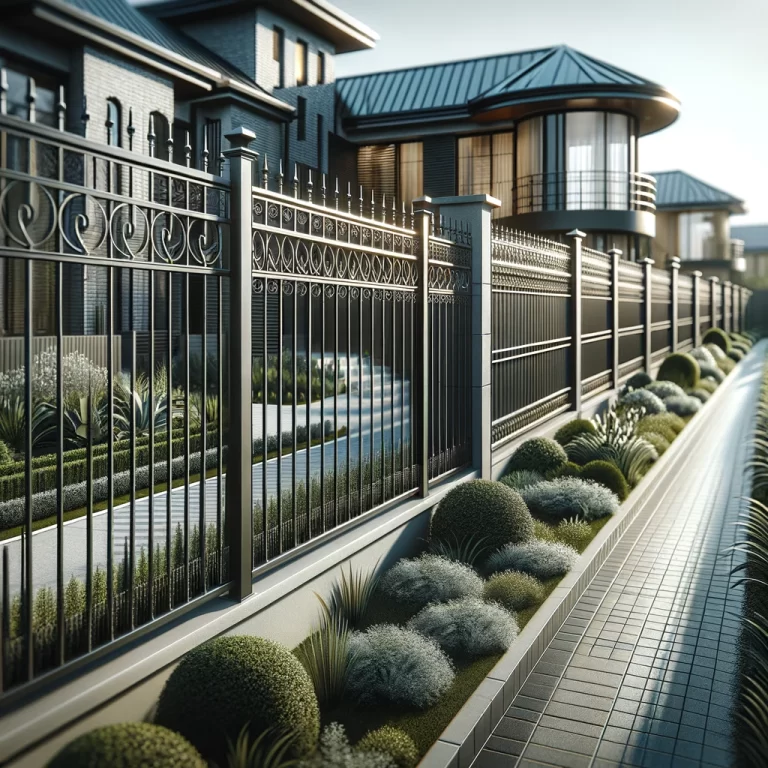Metal fence posts are a popular choice for homeowners due to their durability and strength. One common concern with metal fence posts is rust. In this article, we will explore the different types of metal fence posts such as steel, aluminum, and iron, and discuss the causes of rust on these posts. We will also provide tips on how to prevent rust, check for signs of rust, repair rusty posts, and even replace them if necessary. Stay tuned to learn how to keep your metal fence posts looking their best!

What Are Metal Fence Posts?
Metal fence posts are essential components in fencing systems, providing structural integrity and support for various types of fencing materials.
The role of metal fence posts in fencing systems is crucial for ensuring that the fence stands strong and secure over time. These posts serve as the backbone of the fence, holding up the weight of the fencing materials and providing stability against external forces. Metal fence posts are often treated with protective coatings to prevent rust and corrosion caused by exposure to the elements.
This not only enhances the longevity of the posts but also contributes to the overall durability of the fencing system. The protective coatings act as a barrier, shielding the metal from moisture, UV rays, and other factors that can cause deterioration.
What Are the Different Types of Metal Fence Posts?
Metal fence posts come in various types, including steel, aluminium, and iron, each offering unique characteristics and benefits for different fencing applications.
Steel fence posts are popular for their strength and durability, making them ideal for securing heavy-duty fencing materials like chain link or wrought iron. They are also resistant to corrosion, which is advantageous in areas with high moisture levels.
On the other hand, aluminium posts are lighter in weight compared to steel, making them easier to install and transport. Aluminium is rust-resistant, making it suitable for coastal regions where salt exposure is a concern.
Iron fence posts, while heavier than aluminium, provide a classic and elegant look that complements traditional wrought iron fencing designs. They are commonly used for decorative purposes and can withstand harsh weather conditions. Iron posts may require more maintenance to prevent rusting compared to steel and aluminium options.
Steel Fence Posts
Steel fence posts, especially galvanised steel posts known for their rust resistance, are preferred for their durability and strength in supporting fencing structures.
Regarding fencing solutions, the rust resistance of steel fence posts is a crucial feature that ensures longevity and minimal maintenance demands. The galvanisation process adds a protective layer to the steel, making it highly resistant to corrosion caused by outdoor elements like rain and snow. The strength of these posts due to galvanisation reinforces the overall stability of the fence, offering reliable support even in harsh weather conditions.
Aluminium Fence Posts
Aluminium fence posts present an aesthetic challenge due to their visual appeal and lightweight properties, making them ideal for modern fencing designs.
The sleek and contemporary look of aluminium posts adds a touch of sophistication to any outdoor space while also providing durability and longevity.
Their lightweight nature makes installation a breeze compared to heavier materials, allowing for easier handling and positioning during the fencing project.
When choosing the right attachment method for securing aluminium fence posts, it’s crucial to consider the specific requirements of your fence design to ensure a stable and secure installation.
Iron Fence Posts
Iron fence posts offer a classic and timeless appeal, adding elegance to fencing designs, but require proper attachment accessories for stability and longevity.
Regarding iron fence posts, their durability and strength are renowned, making them a popular choice for both residential and commercial properties. These posts not only provide security but also enhance the aesthetic value of any property with their intricate designs and sturdy construction.
Choosing high-quality attachment accessories is crucial to ensure that these iron posts remain securely in place for years to come. Whether it’s brackets, screws, or bolts, each component plays a vital role in maintaining the structural integrity of the fencing system.
Do Metal Fence Posts Rust?
Metal fence posts are susceptible to rust and corrosion due to environmental factors, highlighting the importance of rust prevention methods to maintain their longevity.
Rust and corrosion can significantly weaken metal fence posts over time, leading to structural instability and an unsightly appearance. The formation of rust is often accelerated in areas with high moisture levels or where the posts are in constant contact with the ground. Without proper protection, the metal can deteriorate rapidly, compromising the overall integrity of the fence.
Protective coatings play a crucial role in safeguarding metal fence posts against corrosion. Coatings such as galvanization or specialised paints create a barrier that shields the metal from moisture and other corrosive elements. Regular maintenance, including inspections for any signs of rust or damage, allows for early intervention and ensures that any issues are addressed promptly.
What Causes Metal Fence Posts to Rust?
Metal fence posts rust primarily due to exposure to environmental conditions that accelerate the corrosion process, especially when protective zinc coatings are compromised.
When metal fence posts are installed, they are subjected to a variety of weather elements such as moisture, oxygen, and salt, which promote the formation of rust. Moisture, in particular, plays a critical role in rust development by providing the necessary medium for the oxidation of iron in the metal. The presence of oxygen in the air initiates the electrochemical reaction that leads to corrosion on the surface of the posts. Exposure to salt, commonly found in coastal regions, can significantly accelerate the rusting process due to its corrosive nature.
The accelerated corrosion process not only compromises the aesthetic appeal of the fence but also weakens its structural integrity, making it prone to damage and decay over time. Rust formation can penetrate deep into the metal, leading to weakening of the fence posts and eventually causing structural failure. This deterioration can result in safety hazards and costly repairs for property owners.
Fortunately, the application of zinc coatings on metal fence posts serves as a protective barrier against rust formation. Zinc coatings act as a sacrificial layer that corrodes instead of the underlying metal, delaying the onset of rust and extending the lifespan of the posts. By galvanising the metal with zinc, the posts are shielded from environmental factors that promote corrosion, thereby maintaining their durability and longevity. Regular maintenance and inspection of zinc coatings are essential to ensure their effectiveness in preventing rust and preserving the integrity of metal fence posts.
How Can You Prevent Metal Fence Posts from Rusting?
Preventing rust on metal fence posts involves applying protective coatings, regularly managing rust through inspections, and promptly removing any signs of corrosion to maintain the posts’ durability.
One effective method for preventing rust on metal fence posts is to apply protective coatings. This creates a barrier between the metal surface and environmental factors that can cause corrosion. Common protective coatings include paint, epoxy, or specialised rust-inhibiting solutions.
Along with this, implementing proactive rust management strategies is crucial. Regularly inspecting the fence posts for any early signs of rust such as discolouration, flaking, or pitting can help catch corrosion in its initial stages. This allows for prompt intervention and treatment before the rust spreads and causes severe damage.

What Are the Signs of Rust on Metal Fence Posts?
Property owners should regularly inspect their metal fence posts for signs of rust, such as discolouration, flaking, or corrosion spots that indicate the need for maintenance.
Keep an eye out for
- rusty residue on the ground near the posts,
- uneven surfaces or rough textures on the metal,
- and a weakening structure manifested through warping or sagging.
Identifying rust early is crucial to preventing further deterioration, which can compromise both the aesthetics and strength of the fencing. Regularly cleaning the posts, applying rust-resistant coatings, and addressing any signs of rust promptly can help prolong the lifespan of the metal fence and maintain its visual appeal.
How to Check for Rust on Metal Fence Posts?
To check for rust on metal fence posts, inspect the quality of the steel by looking for discolouration, peeling coatings, or any signs of corrosion that may indicate rust formation.
Next, focus on examining the structure of the metal fence posts. Check for any areas where the steel appears weakened or shows signs of stress such as cracks, bends, or warping. These structural issues can compromise the integrity of the posts and make them more susceptible to rust.
Additionally, inspect the joints and connections for any signs of rust or loosening. Properly securing the connections helps maintain the overall stability of the fence. Regularly clean the metal posts to remove dirt and debris which can accelerate the rusting process.
Can You Repair a Rusty Metal Fence Post?
Repairing a rusty metal fence post is possible through maintenance practices that involve removing rust, applying protective coatings, and restoring its appearance for enhanced durability.
For rust removal, start by scrubbing the post using a wire brush or steel wool to eliminate loose particles.
- After cleaning, use a rust converter to transform any remaining rust into a stable compound.
- Next, apply a primer designed for metal surfaces to prevent new rust formation.
- Choosing a durable, weather-resistant paint for the final coating can significantly extend the post’s lifespan.
To enhance the post’s appearance, consider adding decorative elements or using a post cap to both protect and improve its aesthetic appeal.
How to Remove Rust from Metal Fence Posts?
Removing rust from metal fence posts can be achieved by using rust removal products, wire brushes, or sanding methods to restore the post’s surface and prevent further corrosion, especially in concrete-embedded posts.
When dealing with rust on metal fence posts, it is vital to select the appropriate rust removal product based on the severity of the corrosion. For light rust, a mild acidic solution or a commercial rust converter can be effective. For heavier rust, a more abrasive product like naval jelly or a rust dissolver may be necessary.
Once the appropriate product is chosen, use a wire brush to scrub off the loose rust particles gently. Be cautious not to apply too much force, as it may damage the metal surface. For concrete-embedded posts, special attention must be given to avoid compromising the structural integrity during the rust removal process.
If the rust is deeply entrenched in the metal, sanding the surface can be a more extensive but effective method. Start with coarse-grit sandpaper to remove the bulk of the rust, then switch to finer grits to smoothen the surface. After sanding, applying a rust inhibitor or primer can help prevent future rust formation and protect the metal against corrosion.
How to Treat Rust on Metal Fence Posts?
Treating rust on metal fence posts involves applying protective coatings, managing existing rust through removal methods, and implementing preventative measures to maintain the post’s integrity and appearance.
Protective coatings are crucial in preventing rust formation on metal fence posts. The application of a high-quality rust-resistant coating creates a barrier against moisture and oxygen, the main culprits behind rust.
For managing existing rust, techniques like wire brushing, sanding, or using chemical rust converters can be employed to remove the rust and restore the metal surface. Proactive strategies such as regular inspections, timely repairs, and keeping the posts dry can significantly reduce the chances of future rust formation, ensuring the longevity and aesthetics of the fence posts.
How to Replace a Rusty Metal Fence Post?
Replacing a rusty metal fence post requires the use of appropriate tools, such as Stock & Noble accessories, for secure installation and ensuring the structural integrity of the fencing system.
When embarking on the process of replacing rusty metal fence posts, it is essential to gather all the necessary tools and equipment to carry out the task efficiently. The primary tools required include a post hole digger, a level, a tape measure, a sledgehammer, and work gloves for safety.
Having high-quality accessories like sturdy metal brackets, durable screws, and rust-resistant coatings from a reputable brand like Stock & Noble can greatly enhance the longevity and durability of the new fence post. These high-quality products ensure that the replacement post is sturdy and can withstand various weather conditions for years to come.
What Tools Do You Need to Replace a Rusty Metal Fence Post?
To replace a rusty metal fence post effectively, you will need tools such as post hole diggers, concrete mix, and attachment accessories like the Buckley option for a secure and stable installation.
Before starting the replacement process, it’s important to gather all the necessary tools and materials. Along with post hole diggers and concrete mix, make sure to have a level, tape measure, gravel, water, and a new metal fence post at hand.
Regarding the attachment method, using the Buckley option is highly recommended for its durability and ability to withstand various weather conditions. This specialised attachment ensures that the new post is securely anchored in place, reducing the risk of future rust and instability.
Now, let’s dive into the step-by-step process of replacing a rusty metal fence post:
- Step 1: Digging out the old post – Use the post hole diggers to carefully remove the old post along with any concrete or gravel around it.
- Step 2: Setting the new post – Place the new metal fence post in the hole and ensure it is plumb using a level.
- Step 3: Adding concrete mix – Pour the concrete mix around the post, making sure it is evenly distributed and sturdy.
- Step 4: Securing with the Buckley option – Attach the Buckley option to the post and ensure it is tightened securely for a stable installation.
- Step 5: Finishing touches – Allow the concrete to set as per the manufacturer’s instructions and backfill the hole with soil or gravel.





